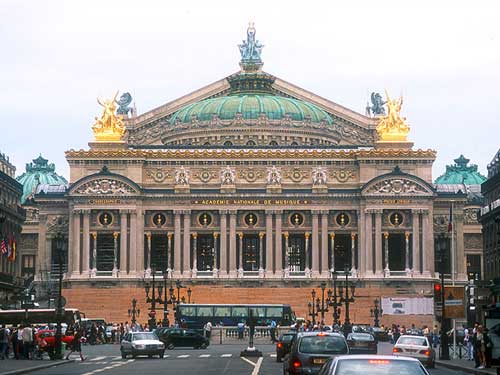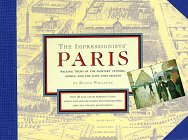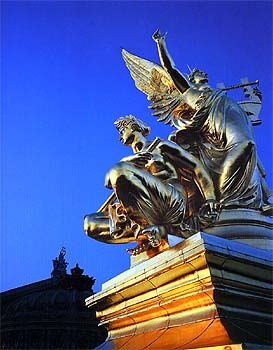|
The Eiffel Tower
 The Eiffel Tower became a figure so much a symbol of Paris which it is quite difficult to see one without thinking of the other. It is certainly the most known monument in the world, in any case more photographed.
Its construction begins on January 23, 1887 with the engineer Gustave Eiffel. The assembly of the 15 000 metal parts finished in Mars 1889 and symbolized the World's Fair which took place in the Champs de Mars.
Dedicated to the demolition and often criticized, the Eiffel Tower was little by little incorporated in the Parisian landscape at the point to become inseparable about it. With its 310 meters top and 7 000 tons, it was the world's tallest building until 1930.
The Eiffel Tower became a figure so much a symbol of Paris which it is quite difficult to see one without thinking of the other. It is certainly the most known monument in the world, in any case more photographed.
Its construction begins on January 23, 1887 with the engineer Gustave Eiffel. The assembly of the 15 000 metal parts finished in Mars 1889 and symbolized the World's Fair which took place in the Champs de Mars.
Dedicated to the demolition and often criticized, the Eiffel Tower was little by little incorporated in the Parisian landscape at the point to become inseparable about it. With its 310 meters top and 7 000 tons, it was the world's tallest building until 1930.
Since 1986, a new lighting emphasizes the night, its fantastic metal frame and consolidates the Capital of France in its fame of City of Light.
The Opera Garnier
 The Palais Garnier is the thirteenth theatre to house the Paris Opera since it was founded by Louis XIV in 1669. It was built on the orders of Napoleon III as part of the great Parisian reconstruction project carried out by Baron Haussmann. The project for an opera house was put out to competition and was won by Charles Garnier, an unknown 35-year-old architect. Building work, which lasted fifteen years, from 1860 to 1875, was interrupted by numerous incidents, including the 1870 war, the fall of the Empire and the Commune. The Palais Garnier was inaugurated on 15 January 1875."
The Palais Garnier is the thirteenth theatre to house the Paris Opera since it was founded by Louis XIV in 1669. It was built on the orders of Napoleon III as part of the great Parisian reconstruction project carried out by Baron Haussmann. The project for an opera house was put out to competition and was won by Charles Garnier, an unknown 35-year-old architect. Building work, which lasted fifteen years, from 1860 to 1875, was interrupted by numerous incidents, including the 1870 war, the fall of the Empire and the Commune. The Palais Garnier was inaugurated on 15 January 1875."
 VIEW LA TRAVIATA HIGHLIGHTS
Placido Domingo and Teresa Stratas in beautiful opera film by Franco Zeffirelli
The Montmartre
 The Montmatre Hill dominate any Paris top of its 130 meters and get its name of the Mount of the Martyrs (the bishop of Paris St-Denis, Rustique and EleuthËre would have been decapitated there towards 250). A convent of nones installed on the hillock in XII century and became the seat of a powerful abbey.
The Montmartre Hill is the center of the events of the Commune in 1871. The end of XIX century makes of Montmatre the center of attraction of the artistic life of Paris and the life of Boheme. From Berlioz to Picasso while passing through Aristide Briant with the Lapin Agile, large artists made famous the Hill which will preserve its intellectual and artistic hegemony until the First World War.
The Montmatre Hill dominate any Paris top of its 130 meters and get its name of the Mount of the Martyrs (the bishop of Paris St-Denis, Rustique and EleuthËre would have been decapitated there towards 250). A convent of nones installed on the hillock in XII century and became the seat of a powerful abbey.
The Montmartre Hill is the center of the events of the Commune in 1871. The end of XIX century makes of Montmatre the center of attraction of the artistic life of Paris and the life of Boheme. From Berlioz to Picasso while passing through Aristide Briant with the Lapin Agile, large artists made famous the Hill which will preserve its intellectual and artistic hegemony until the First World War.
Disneyland
 In five years time, Disneyland Paris became Paris' biggest attraction. A must for children, the park will please all ages with its various attractions and beautiful green setting. The hotels around the park can be a good choice for a stay in the Paris region as the park is conveniently connected by the metro to the city. So, come to Paris and enjoy the Disney world at its best.
In five years time, Disneyland Paris became Paris' biggest attraction. A must for children, the park will please all ages with its various attractions and beautiful green setting. The hotels around the park can be a good choice for a stay in the Paris region as the park is conveniently connected by the metro to the city. So, come to Paris and enjoy the Disney world at its best.
The Impressionists' Paris

One could hardly visit Paris without viewing the work of the French impressionist painters, whose innovative take on the City of Light left an indelible mark on the art world. This charming little hardcover, perfect for the pocket or backpack, allows travelers to venture beyond the museum walls and trace the footsteps of these great artists, including Claude Monet, Edgar Degas, and Edouard Manet, just to name a few. Three city walking tours--surprisingly manageable considering the city's size--cover not only the sites depicted in many of their paintings, but also "the studios in which they worked, the buildings where they lived, and--this being Paris--the cafes in which they gathered." Expertly organized and packed with fascinating facts, including topographical and historical notes, detailed city maps and legends, recommendations for conveniently located restaurants, anecdotes about the artists and their work, and reproductions of the paintings, The Impressionists' Paris "brings the museum experience out into the real world, to better appreciate both the art and the city, one through the other.
Fashion
Paris is a world mecca of fashion. With the likes of Cardin, Dior, Chanel, Yves Saint Laurent, Christian Lacroix, French "grands couturiers"are setting the trend. Most of these firms are located Avenue Montaigne near the Champs-Elysées or rue du Faubourg Saint-Honoré near the Elysées presidential palace.
Bon appetit!
Paris is the city of fine food. You can of course go to one of the many restaurants in town. You can also go to one of the typical street markets with their assortment of fine food. We would also like to give you a list of very special shops where you can as a traveller find the finest and most typical French food.
The Louvre
The Louvre museum is the best known of the many Paris's museums. As one of the finest and largest art museums in the world, it deserves special attention. The large collection of impressionist paintings at the Orsay museum also attracts many visitors.
 The Louvre, the richest of museums, has stood for more than 800 years and reflects stages of change in French life through the centuries. Important rulers left their mark on the Louvre by tearing down and rebuilding and gathering extraordinary works of art. The earliest known building was a fortress built about 1190; however, a Frankish tower or fortified area probably existed at the end of the fifth century. The fortress not only protected the city of Paris from invasions from the west but protected the king from his own subjects on the east. This fortress served as an arsenal, its dungeons housed political prisoners, and its rooms held the royal treasures--icons, armor, manuscripts, and jewelry.
The Louvre, the richest of museums, has stood for more than 800 years and reflects stages of change in French life through the centuries. Important rulers left their mark on the Louvre by tearing down and rebuilding and gathering extraordinary works of art. The earliest known building was a fortress built about 1190; however, a Frankish tower or fortified area probably existed at the end of the fifth century. The fortress not only protected the city of Paris from invasions from the west but protected the king from his own subjects on the east. This fortress served as an arsenal, its dungeons housed political prisoners, and its rooms held the royal treasures--icons, armor, manuscripts, and jewelry.
 By about 1400, the Louvre had become a royal retreat where banquets, tournaments, and state occasions were held. It was at this time that elaborate gardens were added and an aviary for exotic birds as well as a host of wild animals. The Louvre lost its military importance when a group of merchants seized possession and moved city walls beyond the Louvre. It became a part-time residence for the kings but still served as an arsenal and prison. Charles V had countless architects, builders, decorators, and artists to modernize and enlarge the Louvre. He added two new wings to replace the north and east walls. This "marvel to behold" no longer exits.
In 1415, the French were conquered by the English who then plundered the Louvre. Afterwards, marauders came in and took anything the English had left. Some of the original Louvre treasures now belong to other European museums. The Louvre, just an arsenal and prison once again, was neglected for 150 years and its buildings fell into ruin. In 1527, the structure was torn down by Francis I and required four months to be demolished. The thinking of the day was that the royal residence should reflect wealth and culture rather than the might of its ruler. Thus, Francis I, in 1546, put artisans to work erecting a palace, the beginning of the Louvre as we know it today. Francis I died just eight months later, and his son, Henry II, continued the building efforts with such style and grace that the Louvre personifies all that is meant by "French taste."
By about 1400, the Louvre had become a royal retreat where banquets, tournaments, and state occasions were held. It was at this time that elaborate gardens were added and an aviary for exotic birds as well as a host of wild animals. The Louvre lost its military importance when a group of merchants seized possession and moved city walls beyond the Louvre. It became a part-time residence for the kings but still served as an arsenal and prison. Charles V had countless architects, builders, decorators, and artists to modernize and enlarge the Louvre. He added two new wings to replace the north and east walls. This "marvel to behold" no longer exits.
In 1415, the French were conquered by the English who then plundered the Louvre. Afterwards, marauders came in and took anything the English had left. Some of the original Louvre treasures now belong to other European museums. The Louvre, just an arsenal and prison once again, was neglected for 150 years and its buildings fell into ruin. In 1527, the structure was torn down by Francis I and required four months to be demolished. The thinking of the day was that the royal residence should reflect wealth and culture rather than the might of its ruler. Thus, Francis I, in 1546, put artisans to work erecting a palace, the beginning of the Louvre as we know it today. Francis I died just eight months later, and his son, Henry II, continued the building efforts with such style and grace that the Louvre personifies all that is meant by "French taste."
Henry II had such imagination and grand plans for the Louvre that it was more than 300 years before these plans became reality. Each king after Henry II attempted to complete the plans for the Louvre--it was a "work-in-progress." At times it was a strange mix--new buildings finished and unfinished, ancient structures in the midst of new buildings, and old battlements and towers that were strongholds as well as palace. Construction was interrupted on occasion by civil strife, but only briefly.
 During the reign of Henry IV, the Louvre began to become the artistic capital of the world. Hundreds of artists and craftsmen lived in the Louvre as guests of the king, a royal tradition which continued until the reign of Napoleon I. Under Louis XIV, the government made it its business to promote art, and by the early 1700's the royal collection contained more than 2400 objects of art. New wings were added to the Palace of the Tuileries, which housed the residence and throne room of Louis XIV; the Petite Galerie, built for Catharine de Medicis, was enlarged; buildings were constructed on three sides of the quadrangle of the old Louvre; the Gallery of the Kings, which had burned previously, was replaced by the Gallery of Apollo. The Louvre was nearing completion; however, when Louis XIV moved to Versailles the Louvre began to fall into disrepair. Hovels and trash filled its courtyards, shops were set up in its entrances, and the poor set up residence in its unfinished buildings. Courtiers lived inside the Louvre's apartments and made changes to suit their own taste. Paris tried to make the Palace a city hall, thus saving it, but the king rejected the idea.
During the reign of Henry IV, the Louvre began to become the artistic capital of the world. Hundreds of artists and craftsmen lived in the Louvre as guests of the king, a royal tradition which continued until the reign of Napoleon I. Under Louis XIV, the government made it its business to promote art, and by the early 1700's the royal collection contained more than 2400 objects of art. New wings were added to the Palace of the Tuileries, which housed the residence and throne room of Louis XIV; the Petite Galerie, built for Catharine de Medicis, was enlarged; buildings were constructed on three sides of the quadrangle of the old Louvre; the Gallery of the Kings, which had burned previously, was replaced by the Gallery of Apollo. The Louvre was nearing completion; however, when Louis XIV moved to Versailles the Louvre began to fall into disrepair. Hovels and trash filled its courtyards, shops were set up in its entrances, and the poor set up residence in its unfinished buildings. Courtiers lived inside the Louvre's apartments and made changes to suit their own taste. Paris tried to make the Palace a city hall, thus saving it, but the king rejected the idea.
 In 1793, after the French revolution, the Louvre became a public museum. Art was no longer available only to the upper classes, but became accessible to everyone. All through the 19th century and since, many collectors of art have donated priceless works to the Louvre, requiring more buildings to house these collections. Napoleon instituted renovations of both the interior and exterior of the Louvre and removed all the shops and hovels that filled the Louvre in the 18th century. This period in the history of the Louvre is referred to as the Restoration.
In 1793, after the French revolution, the Louvre became a public museum. Art was no longer available only to the upper classes, but became accessible to everyone. All through the 19th century and since, many collectors of art have donated priceless works to the Louvre, requiring more buildings to house these collections. Napoleon instituted renovations of both the interior and exterior of the Louvre and removed all the shops and hovels that filled the Louvre in the 18th century. This period in the history of the Louvre is referred to as the Restoration.
Napoleon III gave the Louvre its final form. He had two blocks of buildings constructed to join the wings of the Louvre to the Tuileries; however, the Palace of the Tuileries was later burned and demolished, then replaced by the Gardens of the Tuileries. The Louvre is unique to French culture, but it belongs to all mankind.
Notre Dame
 Notre Dame de Paris, more than seven hundred years old, is only the most recent of holy houses to occupy this ancient sacred ground. The Celts held their services on this island in the seine, and atop their sacred groves the Romans built their own temple to Jupiter. In the early years of Christianity, a basilica dedicated to St. Etienne was constructed around 528 by Childebert. A church in the Romanesque manner replaced the basilica, and this stood until 1163 when work began on the structure which stands today.
Notre Dame de Paris, more than seven hundred years old, is only the most recent of holy houses to occupy this ancient sacred ground. The Celts held their services on this island in the seine, and atop their sacred groves the Romans built their own temple to Jupiter. In the early years of Christianity, a basilica dedicated to St. Etienne was constructed around 528 by Childebert. A church in the Romanesque manner replaced the basilica, and this stood until 1163 when work began on the structure which stands today.
 Constructed in three stages, the cathedral was completed in 1250. This period witnessed Paris coming into its own force as a center of political power and commerce. No expense was spared in creating a church that would reflect the capital's newly won prestige. These were the 'development' years of early Gothic architecture, it was essential that Paris should contain an impressive cathedral featuring innovations to surpass such smaller towns as Sens and Noyon. An advantage which Paris possessed over other sites, was that the construction efforts were supported and encouraged by the the king, Louis VII.
Constructed in three stages, the cathedral was completed in 1250. This period witnessed Paris coming into its own force as a center of political power and commerce. No expense was spared in creating a church that would reflect the capital's newly won prestige. These were the 'development' years of early Gothic architecture, it was essential that Paris should contain an impressive cathedral featuring innovations to surpass such smaller towns as Sens and Noyon. An advantage which Paris possessed over other sites, was that the construction efforts were supported and encouraged by the the king, Louis VII.
 King Louis VII must be considered among the handful of influential figures during the rise of the Gothic style in France. It is certain that without the influence of the King's support, Abbot Suger would never have realized his vision of reconstructing Saint-Denis. At the Abby of Saint-Denis, the sparks of inspiration were kindled which would ignite the fires of the cathedral building age. Some twenty years later, the king lent this same support to the construction of the new cathedral of Paris. Louis supported the work with generous and gracious contributions. Clearly he had motivations for strengthening France's eminence as the stronghold of Christendom, but his piety must be considered authentic in the perspective of history.
King Louis VII must be considered among the handful of influential figures during the rise of the Gothic style in France. It is certain that without the influence of the King's support, Abbot Suger would never have realized his vision of reconstructing Saint-Denis. At the Abby of Saint-Denis, the sparks of inspiration were kindled which would ignite the fires of the cathedral building age. Some twenty years later, the king lent this same support to the construction of the new cathedral of Paris. Louis supported the work with generous and gracious contributions. Clearly he had motivations for strengthening France's eminence as the stronghold of Christendom, but his piety must be considered authentic in the perspective of history.
|














 View fascinating movies about France
View fascinating movies about France 









